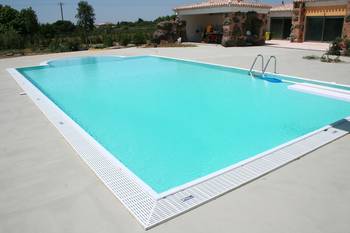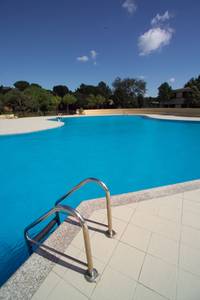Swimming Pool Structure
This section will help you discover the different ways in which a swimming pool is made and how it can be built to better target your purchase. “Take a dip.” you too, in the different sections of this page: you will find useful information to make your choice easier.
STAINLESS STEEL
The top choice for elasticity and strength in a single structure.
The use of modular stainless-steel panels, coated directly in the factory with a layer of hot-rolled PVC (a revolutionary patent of Piscine Castiglione’s Myrtha technology) allows you to combine the advantages of the design freedom of concrete with the speed of construction typical of swimming pools prefabricated.
With a self-supporting and anti-seismic structure that offers a guarantee of a very long life, particularly suitable, thanks to its reduced weight on the ground, to be used also for creating, for example, swimming pools on attics and terraces. Ideal for resisting the pressure of water and backfilling soil. Currently, the top in the sector for structural solidity.
GALVANIZED STEEL
Great style for everyone. The simplest method, from the project’s inception to the installation.
A highly recommended solution for those who want to create an elegant and functional swimming pool with excellent value for money. Equally the result of the innovative modular technology of Piscine Castiglione which, in the Piscine BlueStyle line, uses hot-galvanized prefabricated steel panels, bolted and supported by sturdy buttresses, also in steel. Panels with internal coating in reinforced thick PVC, cut, welded, and laid on site. The great static strength of steel (the real strength of the structure) allows you to make everything easier, from the design phase to the installation of the swimming pool.
The guarantee of building systems with:
- Flawless aesthetic results
- Superior constructive solidity
- Faster and simplified installation
- Significant containment of both labor and maintenance costs
REINFORCED CONCRETE
The most traditional system but with fewer guarantees of efficiency.
Until a few decades ago, reinforced concrete was the most used system for the construction of swimming pools. A system that offers ample design freedom, but today is less widespread due to the numerous drawbacks it presents, including: longer times and construction costs, higher periodic maintenance costs, less guarantee of durability, due to the high risk of corrosion of the structure.
In fact, concrete in itself does not hold water. To make it suitable for the construction of a swimming pool, it must therefore be built as a monolith with dimensions and precautions to avoid the formation of cracks: double-crossed iron reinforcement, expansion joints, waterproof plaster. This is because the swimming pool must be immune to even the smallest cracks. In fact, the presence of microcracks (also possible due to the withdrawal of the cement during the maturation phase or for small settlements of the soil) is sufficient to allow the aggressive water of the swimming pool to attack the iron of the reinforcement, which swells due to the oxidation and, due to the action of rust, tends to corrode and crack over time.
FORMWORK CONCRETE
The cheapest technology.
The system of disposable formwork for reinforced concrete walls is made with the laying of panels and blocks of expanded polystyrene or compressed polystyrene (composed of linear, angular and curved elements) facing each other, suitable for hosting the concrete casting, subsequently to the excavation and preparation of the stalls. It has the advantage of being the most economically convenient technology for creating functional swimming pools for domestic use, despite the drawback of the lower level of finish and structural solidity.
FIBERGLASS
Excellent aesthetic impact with a high risk of deterioration.
The pools with predefined fiberglass molds have a very pleasant appearance at first glance, as well as offering an immediate perception of the finished swimming pool. Over the years, however, they lose gloss and degrade easily due to the rapid wear of the surface layer of their coating, the gel-coat.
After time, the fiberglass begins to absorb water, swell and, consequently, the swimming pool deteriorates. They also have the disadvantage of having a low possibility of customization and of requiring higher costs and transport difficulties (by helicopter or other special means).




